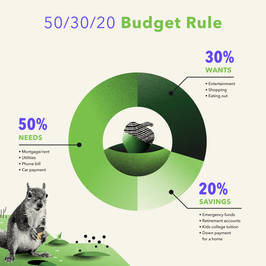5 Steps to Track Spending

You're at the register, and your credit card is declined. Or you start to pay your bills and realize your account is overdrawn. Or you simply don't know why you don't have enough cash to start saving for the future.
It’s a common problem — a 2021 survey from Equifax found that 58% of people said they run out of money at the end of the month. If this is something you’re struggling with, it’s time to track your spending.
5 steps to track your spending
Tracking your spending is key to getting your finances in order. It may sound daunting, but it doesn't have to be. In fact, you can better manage your money and identify your spending habits in just five steps:
1. Track any incoming money
Think about all of the income that you have coming in regularly each month. Include income from your job, any side hustles and other sources of funds, such as child support or alimony. For the sake of budgeting, look at your net income — the amount you have after taxes and other deductions are removed.
2. Write down everything you spend money on
Now that you know how much money you have coming in and going out every month, the next step is to write down everything you spend money on. This step isn’t about judgment or elimination — it’s simply a way to help you figure out where you spend your cash.
You can use a small notepad and pen that you carry with you if you prefer having a hard copy — some people do! — but you can also use the notes feature on your smartphone or expense tracker apps.
3. Categorize your spending
Categorizing your spending can help you determine where your money goes and where you can cut back.
Take a look at both your fixed expenses (the bills that are the same amount every month) and variable expenses (the day-to-day or week-to-week purchases that can fluctuate and, for many people, could cause overspending). Go through your expenses and give each one a category. Total how much you spend in each category per week or month.
Common fixed expenses include:
-
Rent
-
Car payments
-
Health insurance premiums
-
Utilities, like electricity, water, gas, TV, and phone bills
Make sure you consider recurring contributions like saving for retirement or investing.
Next, categorize your variable expenses. Common categories include:
-
Clothing and accessories
-
Entertainment and recreation
-
Fuel and transportation
-
Groceries and dining out
-
Pet care
Because these amounts can vary, look up your statements from your credit cards and bank accounts from the last three months and calculate how much you spent on variable expenses each month. Add up your totals and divide by three to get an average.
4. Create a budget
Building a budget is easier than you may think. Once you’ve started tracking your income and your fixed and variable expenses, you’re already halfway there.
Once you’ve got your monthly income and expenses logged and categorized, subtract your fixed and variable expenses from your income. What’s left is how much money you have to put toward retirement or your emergency fund each month. Ideally, you have some wiggle room between your income and your expenses.
If you’re not making ends meet and are relying on credit to cover the gap — or if your budget is razor thin — it might be time to look for ways to cut your expenses and boost your income, potentially with a side gig.
If you increase your income, make sure you track how much you’re earning per week and month. Because side gigs and extra streams of income can fluctuate, look at the average amount you earn per month.
5. Set a recurring timeline for budgeting
To effectively track your spending and manage your money, set a recurring timeline for yourself.
Some people find they get the best results by sitting down and categorizing and totaling their spending every week, but you can choose a timeframe that works for you. For example, you may spend five minutes before bed every night categorizing your expenses, or you may want to do it all at once at the end of every month.
What is the best way to track your spending?
There are several different ways to track your spending. Which is best for you is dependent on your preferences, so pick a method that's convenient for you:
-
Spreadsheet: You can use programs like Excel or Google Sheets to create a budget. This option is great if you're already comfortable using these programs, and it gives you more flexibility to customize your budget. As an added bonus, they work on both desktop computers and smartphones, so you can edit your spreadsheet even when you’re on the go.
-
Paper copies: Some people find they track their spending better if they use a hard copy notebook. If you find trackers to be motivating, you can look up beautiful bullet journal spending trackers on Pinterest, or you can buy budget notebooks online.
-
Budgeting apps: There are many budgeting apps available. A popular one is Mint, which offers a free option. Other budget apps, such as You Need a Budget or Personal Capital, have premium versions that give you more options and customization. These apps can sync with your bank accounts and credit or debit cards, making it easier to track your spending.
-
Envelope method: The envelope method is a way to track your spending that uses cash. You put a set amount of cash for each category into an envelope, and once the cash in the envelope is gone, you can’t spend any more in that category. Envelope budgeting can work well if you find it difficult to stick to a budget and need physical reminders to stay on track, as it can help you become more conscious of your spending.
Why is it important to track your spending?
Tracking your spending is an essential part of good money management. Particularly if you find yourself overspending, tracking your spending and cash flow can help you figure out where your money goes and identify your spending triggers. It can help you identify weak points and areas for improvement, empowering you to make better financial decisions with spending and saving.
The act of tracking your expenses and giving them categories can also make you more mindful of your money and how you use it. By being more engaged with your financial accounts, you can better plan for the future.
This material has been presented for informational and educational purposes only. The views expressed in the articles above are generalized and may not be appropriate for all investors. The information contained in this article should not be construed as, and may not be used in connection with, an offer to sell, or a solicitation of an offer to buy or hold, an interest in any security or investment product. There is no guarantee that past performance will recur or result in a positive outcome. Carefully consider your financial situation, including investment objective, time horizon, risk tolerance, and fees prior to making any investment decisions. No level of diversification or asset allocation can ensure profits or guarantee against losses. Article contributors are not affiliated with Acorns Advisers, LLC. and do not provide investment advice to Acorns’ clients. Acorns is not engaged in rendering tax, legal or accounting advice. Please consult a qualified professional for this type of service.








